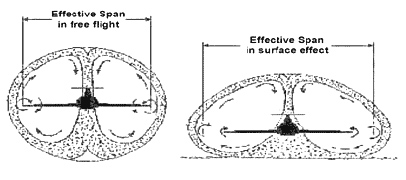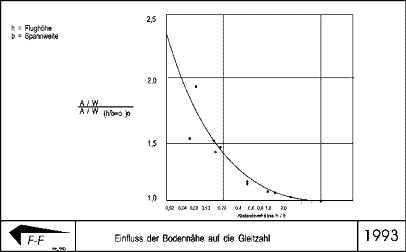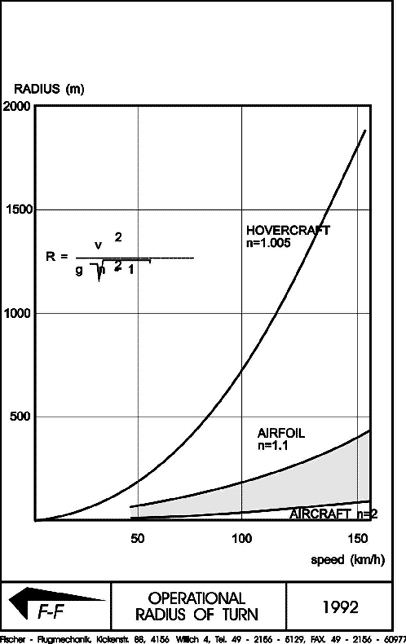
Ground Effect Craft utilize a well know phenomena, where the ratio between lift and drag is highly improved, when a lift creating wing is operated in the vicinity of the ground. Beginning at a height of appr. ½ of the wing span, the glide ratio steadily improves up to a factor of 2.3 at close Ground Effect i.e. 5% of wing span, compared to free flight.

An vehicle with a glide ration of 10 in free flight therefore can improve the glide ratio up to 23 in close Ground Effect, if properly designed, indicating, that in Ground Effect the same craft only produces 40% of the drag, which would occur in free flight or on the other hand is able to carry up to 130% more weight with the same propulsive power. Fig. 1 shows the so-called "Wieselberger Slope" in which the physical phenomena of Ground Effect con be seen.

Figure 1
Fig. 2 shows the position of Ground Effect Craft in comparison to other means of transportation. It is clearly indicated, that Ground Effect Craft have no competitors for over water transport, if low power requirement i.e. economical transport at high speed is required.

Figure 2
Over years, one aerodynamic problem prohibited the utilization of Ground Effect Craft. This reason was the aerodynamic shift of the centre of pressure occurring in changing height from Ground Effect to greater heights. This shift of centre of pressure resulted in so called pitch up tendency, which was not acceptable for commercial applications.
Also for this reason, first manned Ground Effect Craft were designed along military specifications, where the intention was to fly under the enemy radar sight, while being able to temporary rise height in order to enlarge the own radar range. Consequently, those first Ground Effect Craft were registered as aircraft.
The most outstanding design in regard to performance and safety was developed by the German aerodynamist Dr. Alexander Lippisch, referred today to as "Lippisch Design". He combined a high positioned tail surface outside the ground effect with an inverted delta wing, and proofed this in flight as being an aerodynamic inherent longitudinal and height stable configuration.
This stability, together with the origin coming from free flight, results in of the biggest advantages of the Lippisch design: To cruise waves without loss of safety. In the design of the 8-seated over water taxi, developed by AFD, the customer specification required the ability to cruise over 2m high w aves. Due to the small size of the craft, cruise over such wave height is not best economic, but allows safely to maintain flight schedules for the passengers.
Basically, the wave height to be cruised over in economic ground effect mode is determined by the wing span of the craft. As mentioned, economic ground effect begins at about 10% of the wing span. For the ability to cruise 3 m waves economical, a wing span of 30m would be required.
Another advantage of the Lippisch design is the manoeuvrability during turns. Fig. 3compares the possible turn radii of aircraft, Hovercraft and Ground Effect Craft ("Airfoils"). The improvement compared to Hovercraft is significant, and ensures safety.
 Figure 3
Figure 3
This basic design is still used for the HW-Tech, being target of the investigation in the scope of this Feasibility Study.
The above described advantage of efficiency is not the only benefit of Ground Effect Craft.
It is known, that High Speed Wave Piercing Catamarans were expected to be revolutionary for over water transport with their high speed. Actually, the results were disappointing, as under real operational wave conditions, the high speed could not be maintained due to the lack of passenger comfort.
· Ground Effect Craft operate above the waves, NOT touching the water, and not creating sea-sickness. This kind of comfort is not known in today's marine transportation.
· Ground Effect Craft are highly environmental friendly: no exhaust gases in the water, no swell, no danger for water life. · Ground Effect Craft are safe: The landing strip at any time is close by on the water surface.
· Ground Effect Craft are safe: The landing strip at any time is close by on the water surface.